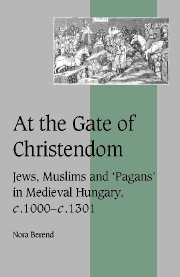Book contents
- Frontmatter
- Contents
- List of maps
- Acknowledgements
- List of abbreviations
- INTRODUCTION
- 1 HUNGARY: A FRONTIER SOCIETY
- 2 CHRISTIANS AND NON-CHRISTIANS
- 3 THE LEGAL POSITION OF HUNGARY'S NON-CHRISTIAN POPULATION
- 4 NON-CHRISTIANS IN HUNGARIAN ECONOMY AND SOCIETY
- 5 CONFLICTS BETWEEN THE PAPACY AND THE KINGS
- 6 CHRISTIAN PERCEPTIONS AND ATTITUDES
- 7 NON-CHRISTIAN COMMUNITIES: CONTINUITY, TRANSFORMATION, CONVERSION AND ASSIMILATION
- CONCLUSION
- Appendix 1 Hungarian kings of the house of Árpád
- Appendix 2 Toponyms, with Latin and German equivalents
- Appendix 3 The manuscript tradition of the Synod of Buda (1279)
- Bibliography
- Index
- Cambridge Studies in Medieval Life and Thought Fourth series
7 - NON-CHRISTIAN COMMUNITIES: CONTINUITY, TRANSFORMATION, CONVERSION AND ASSIMILATION
Published online by Cambridge University Press: 06 January 2010
- Frontmatter
- Contents
- List of maps
- Acknowledgements
- List of abbreviations
- INTRODUCTION
- 1 HUNGARY: A FRONTIER SOCIETY
- 2 CHRISTIANS AND NON-CHRISTIANS
- 3 THE LEGAL POSITION OF HUNGARY'S NON-CHRISTIAN POPULATION
- 4 NON-CHRISTIANS IN HUNGARIAN ECONOMY AND SOCIETY
- 5 CONFLICTS BETWEEN THE PAPACY AND THE KINGS
- 6 CHRISTIAN PERCEPTIONS AND ATTITUDES
- 7 NON-CHRISTIAN COMMUNITIES: CONTINUITY, TRANSFORMATION, CONVERSION AND ASSIMILATION
- CONCLUSION
- Appendix 1 Hungarian kings of the house of Árpád
- Appendix 2 Toponyms, with Latin and German equivalents
- Appendix 3 The manuscript tradition of the Synod of Buda (1279)
- Bibliography
- Index
- Cambridge Studies in Medieval Life and Thought Fourth series
Summary
The coexistence of different groups entails interaction. Interaction can lead to widely different results: clashes, assimilation, changes in the customs of one or both sides, and the subjugation or even extermination of one of the groups. Among the possible outcomes are various forms of acculturation, from the incorporation of selected cultural (including religious) practices and beliefs to the adoption of a whole cultural–religious system. Such influences can be mutual, affecting both sides, or unidirectional, where elements of the dominant culture are adopted by the dominated one. This process can take place peacefully or by violent means. Acculturation can result in syncretism, in the reinterpretation of adopted elements, in the coexistence of two systems, or the replacement of one system by another. This chapter analyses these trends in relation to the three non-Christian groups of Hungary.
An explanation of the sustained existence or assimilation of a group requires the analysis of both Christian and non-Christian attitudes. Declared Christian policies aiming at exclusion or conversion, the subject of previous chapters, were only part of the forces at play. The context of living in a Christian society, the cohesion of non-Christian communities, the degree and means of their resistance all contributed to the preservation or assimilation of these groups. The Jews, Muslims and Cumans of Hungary constituted a small minority within a Christian world.
- Type
- Chapter
- Information
- At the Gate of ChristendomJews, Muslims and 'Pagans' in Medieval Hungary, c.1000 – c.1300, pp. 224 - 267Publisher: Cambridge University PressPrint publication year: 2001



